

While you still have the rotation layer highlighted, select the origin of rotation (it’s a green dot) on the canvas and move it to the the area of the Paste Canvas layer where you want the center point of rotation to be. You’ll need to do that so that you can tell the difference when you start adding your rotation layer hierarchy later. Name the rotate layer the same name as what you named the paste layer. Doing that will add a rotate layer in your Paste Canvas layer. Right click on the top layer in the paste layer and select NEW LAYER>TRANSFORM>ROTATE LAYER. Start by opening your topmost paste layer. Now that all the layers are separated into their respective Paste Canvas layers, you’ll next be adding a rotation layer for each paste layer. I learned the hard way:) Step 3: Add Rotation Layer Adding rotation layer and moving origin If you move the paste layer around on the canvas, it will make your rotation layers not line up. Important Note: Make sure that if you need to move a body part into a better position not to move a paste layer. Naming all layers will ensure success or at least prevent confusion. Make sure you name the paste layer something that makes. After you click the encapsulate icon, you’ll have a Paste Canvas layer with a generic name of ‘Inline Canvas’ layer and the layer contents inside. The easiest way to created a Paste Canvas layer is to select the layers that you want to encapsulate and then press the encapsulate button (green and white pill-like icon) at the bottom of the layers panel.
#Making flash animations with synfig studio manual#
In the tutorials the manual refers to these encapsulated folders as ‘Paste Canvas layers’. This is a way of organizing and controlling your character. For the next step you’ll be placing or “encapsulating” your layers into folders in the layers panel. Sometimes terminology can be difficult to grasp while learning programs. Remember, a clean house is an efficient one:) Step 2: Encapsulate Your Layers by Using Paste Canvas Layers Encapsulate layers inside paste canvas So make sure that you have a handle on your layers. Synfig creates a layer for each fill or outline. While you draw, make sure you properly name your layers. You’ll have tons of layers when you’re done. Step 1: Draw Your Character Draw your characterĭraw your character. I created Thumbalina to make it easy to understand what was going on with my file without it being so complex. There should be no need to export the layers as PNGs and then trace in Synfig:) I believe that their video was created before Synfig could import vector files. Quadro Chave has created a great vimeo video that will take you through the process of preparing vector files to import into Synfig. Synfig is also able to import vector files from programs like Inkscape or Illustrator. Personally, I think it’s smarter to create a vector character from Synfig so that it’s resolution independent. They use an imported png images in order to create a character. I compiled these notes from the cut-out tutorial on the tutorial page for Synfig.


 0 kommentar(er)
0 kommentar(er)
